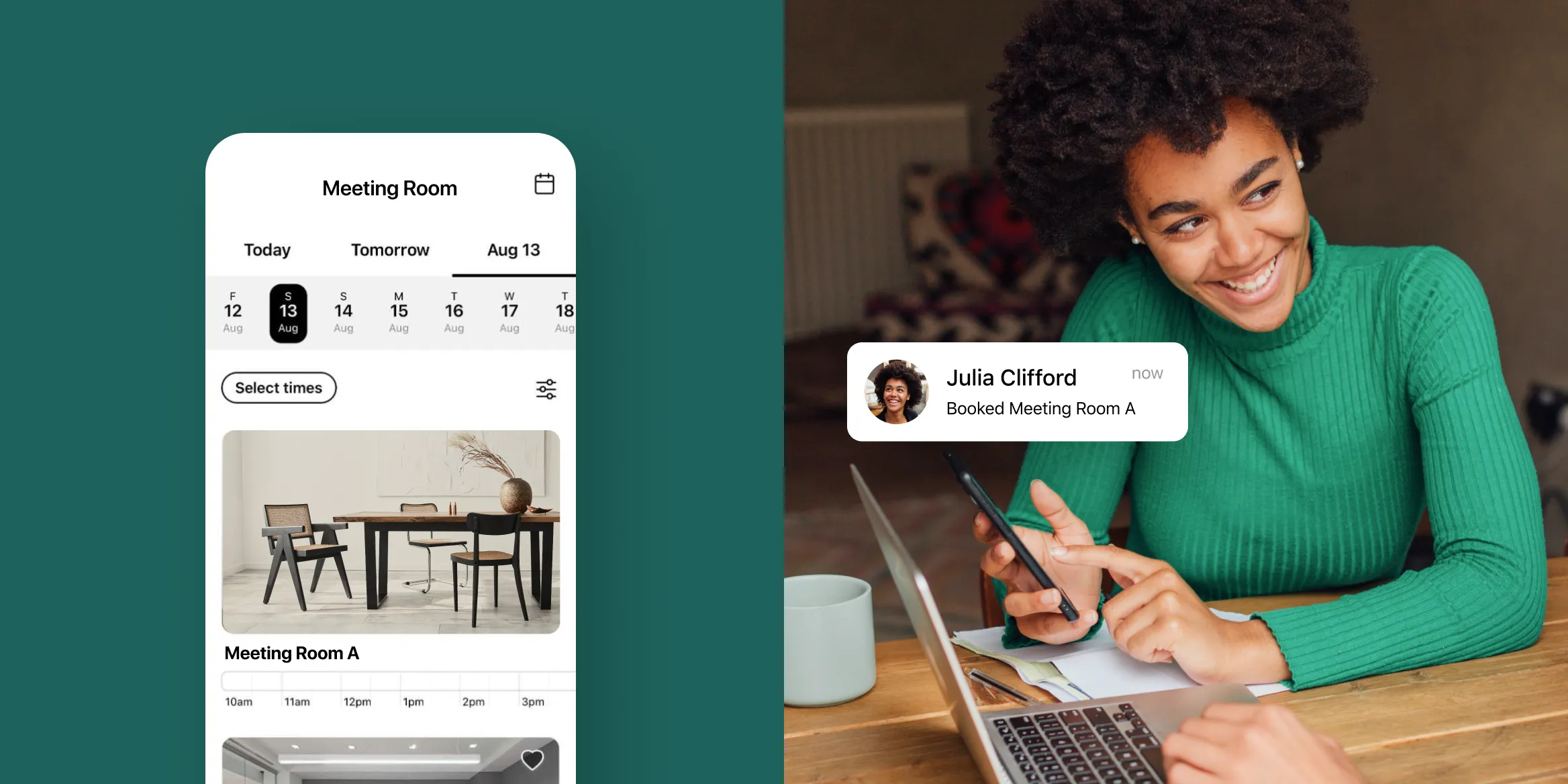
Summary
- There are three types of communication in a coworking environment: internal communication, external communication, communication between members
- Improving all three types can help you improve member retention rates, decrease member churn, and create a strong sense of belonging amongst the community
Communication is a pillar of work productivity in any organization, including coworking spaces.
Good communication within and throughout your coworking space is a proven driver of important business objectives, like retaining members and building a thriving community.
But in this nontraditional office environment, the rules around communication are fuzzy.
In this article, we’re mapping out the nine best practices for internal and external communication within a coworking space so you can start reaping the benefit of great communication immediately.
What do we mean by communication in coworking?
Communication in coworking refers to the various ways that you connect with your team, your members and each other.
This includes:
- Sending an email announcement to members
- Striking up a casual conversation with a coworker over coffee
- Booking a one-on-one meeting with your community manager
- Sending a push notification via a mobile device
Community is built on strong communication skills. If you’re wanting to create a warm and welcoming space where people feel connected, you will absolutely need to consider when and how you communicate with your members.
The benefits of strong communication
In a traditional office, business leaders drive home the need for communication. In a coworking space, good communication is even more critical.
Members are customers — and those who receive a less-than-stellar customer experience may churn.
Here are a few benefits to having strong communication in your space:
- Improved member retention rates
- Decreased member churn
- More sustainable revenue
- Strong sense of belonging amongst the community
- A more rewarding and dynamic experience for members
The three types of coworking communication
There are three forms of communication in a coworking environment:
- Internal communication: communication within and between your management team
- External communication: communication between your management team and your members
- Communication between members
Within each of these communication types, it’s important to consider the messaging, delivery, and mutuality.
How to improve internal communication in your coworking space

Good communication starts with company culture.
Internal communication, between coworking leadership and employees, is the foundation upon which this is built. A solid strategy begins with higher-ups and is engrained in the corporate culture from day one.
Even if you haven’t prioritized communication until now, it’s never too late to start. Here are the best practices for improving internal communication in your coworking business.
1. Share vision, strategy, and expectations 💭
Sharing a clear vision of goals, expectations, strategy, and values is key to establishing good communication.
When leaders model the communication style they expect, employees will follow their lead.
- Share your business roadmap with your team. Include metrics and any data that can help everyone understand business goals
- Make communication visual and include elements of storytelling. The more engaging your delivery, the better your staff will be able to receive and retain the information
- Share ideas. Did you see a cool coworking article? Share thought leadership and other resources with your whole team, not just a select few
2. Use the right tools and avenues of communication ⛏
When it comes to communication, method is as important as message.
Tools like Slack and Zoom are great for communicating within a team, particularly when working remotely or at separate locations.
Whatever tool you choose, make sure it is accessible and consistent. If your team always uses Slack and email to communicate, a stray request via text message could get lost in the mix.
- Keep it simple. Carefully choose the tools you use to communicate and stick with them. Establishing a few select and powerful tools can set both leadership and staff up for success
- Build consistency around communication. Regular, transparent communication sets the groundwork for the future. If a tough conversation arises, your team will already be well versed in the practice of communicating effectively
3. Give and request feedback 🎤
Communication is a two-way street.
Listening, understanding, and responding are all involved in effective two-way communication.
To ensure important messages are received and accepted, establish mutual communication early in working relationships and within company roles. Communicate in a way that is empathetic and understanding.
- Gather feedback. Ask for regular feedback via employee interviews, check-ins, or surveys
- Have an authentic open-door policy. It can help facilitate a two-way street in communication with staff
- Celebrate wins. When your team feels like they are setting and achieving shared goals, a sense of belonging grows. Your members will love seeing a happy, motivated staff
- Praise often and recognize great work. Leaders that offer praise and recognition see a boost in productivity, growth, and positive customer feedback.
Internal communication is often one of the most difficult forms of communication to tackle. However it is also the most important. You can’t run a great business, without a great team.
How to improve external communication in your coworking space

External communication refers to any interactions that happen between representatives of your coworking space and members or leads.
From the receptionist’s greeting to marketing email campaigns, every communication touchpoint with your brand is an opportunity to attract, convert, or retain business.
Here are some best practices that we recommend for improving external communication in your coworking business.
1. Make the in-person experience consistently enjoyable 😄
Members want to feel welcome when they arrive in your space.
From the tone of a greeting to your office tour, every touch point should be consistent for every member.
Ultimately, your members will feel more at home in your space with clear expectations and consistent messaging.
- Determine the ‘vibe’ of your space, and hire for it. Choose naturally friendly staff members. Having people that are knowledgeable about your space’s niche and community adds value for members
- Make a plan. Set policies and procedures in place for handling in-person interactions. A playbook that outlines who is responsible for which communications and when will strengthen your communication strategy
2. Put a strategic marketing plan in place 🎯
Communication in a coworking space happens outside of office hours too.
Your coworking marketing and social media strategy will determine how your members view your brand when they are away from the physical office.
People often think of marketing as a sales role, but a sophisticated marketing operation is primarily about communicating.
- Stay current. Make sure your website is up to date and reflects your correct contact information, hours, and offerings. It should be easy to use and helpful for current or prospective members
- Use a variety of channels for marketing communications. TikTok, Facebook, Instagram, your company blog, partner channels, and others can help you reach your audience online where they already spend time
- Tell stories to engage your audience. Humans are hardwired for storytelling. Adding testimonials, anecdotes, and interviews to your content can help improve your engagement overall
3. Choose transparency and clarity 🌟
Personality, style, and emojis have a place in communications, but the north star of a good external communication strategy should be authenticity.
Aim for clear, useful communications over fluff to gain trust, win credibility, and reassure your members that your space is the best place to work.
- Be consistent in tone and delivery. Whether you’re communicating online or in-person, all communication sources should represent the tone and goals of your overall strategy
- Choose one or two places to share community updates. Your members should know where to expect updates about things that affect their work
- Technology is your friend. Use an app to manage space bookings and send out messages or push notifications to members. When you communicate within the same platform that members use to book space, you guarantee your message will be received
How to improve communication between coworking members

Member communication happens when your members are perpetually engaged and continuing conversations outside of the channels you establish.
In-person collaboration, the exchange of personal phone numbers, and the picking of member brains after hours all work to connect people within your coworking space.
How can coworking operators foster this third-party communication without being overbearing?
Here are our best practices for improving communication between coworking members.
1. Give them something to talk about 🗣
Want members to connect? Give them some material to spark a conversation.
Workshops, speaking events, and other kinds of coworking events will give your members material to connect with organically.
Breaking the ice isn’t easy, particularly among strangers who are working on separate projects. Interesting subjects can stimulate ideas, foster community, and keep members coming back.
- Share ideas and innovations produced within your workplace. Knowing what others are creating in your community is inspiring. When there are wins in your coworking space or flexible workplace, let people know
- Host speakers, workshops, and other events that add value to the people you serve. If your space has a niche, offer professional development opportunities that enrich your members
2. Incorporate elements of the traditional office 🏢
Coworking spaces offer newfound freedom and autonomy to workers. But some structure is a good thing in the workplace.
- Introduce new members. When a new member joins your space, let everyone know who the new face is. This could be as simple as posting a Slack message or as interactive as taking them from desk to desk
- Try adding structure to the workday, like a daily stand-up meeting. Daily morning stand-ups, or scrums, can build routine and open channels of communication between workers. Structure can improve productivity and offer opportunities to partner with their coworkers
3. Be relatable and social 🎵
Some of the best communication happens during social time.
When you create an atmosphere for connection outside of the daily grind, you build bridges to communicate with your members, and for them to communicate with each other.
Social events give people of all backgrounds and experiences a chance to connect on a deeper level. Your business can demonstrate relatability by creating space for communication outside of the work routine.
- Food brings people together. Sharing a meal – be it a weekly breakfast or a food truck event for lunch – can get coworking members engaged, talking, and fed
- Design for communication. A well-placed coffee machine can induce member interaction and encourage conversation. A lounge, kitchen, or lobby can be the place where members chat when they aren’t actively working
Building a coworking community through communication

Community is everything in a coworking business.
Because members always have the option to work elsewhere, creating an atmosphere that evokes a sense of belonging helps with retention — and your bottom line.
Best practices in communication are the foundation of community in a coworking space.
- Adopt a policy of transparency, engagement, and consistency
- Evaluate what communication works in your space (and what doesn’t)
- Adjust your strategy accordingly and be sure to communicate these changes along the way
Ultimately, the best communication strategy is the one that works for your business. With the right communications, your community will begin to grow and self-propel. The hum of a self-sufficient workforce that inspires belonging is your goal.
With the right communication strategy at all levels of your business, you can set the stage for some incredible organic growth of your coworking space!
Ready to grow your coworking business? Take a look at Optix features to see if it’s a good fit.



